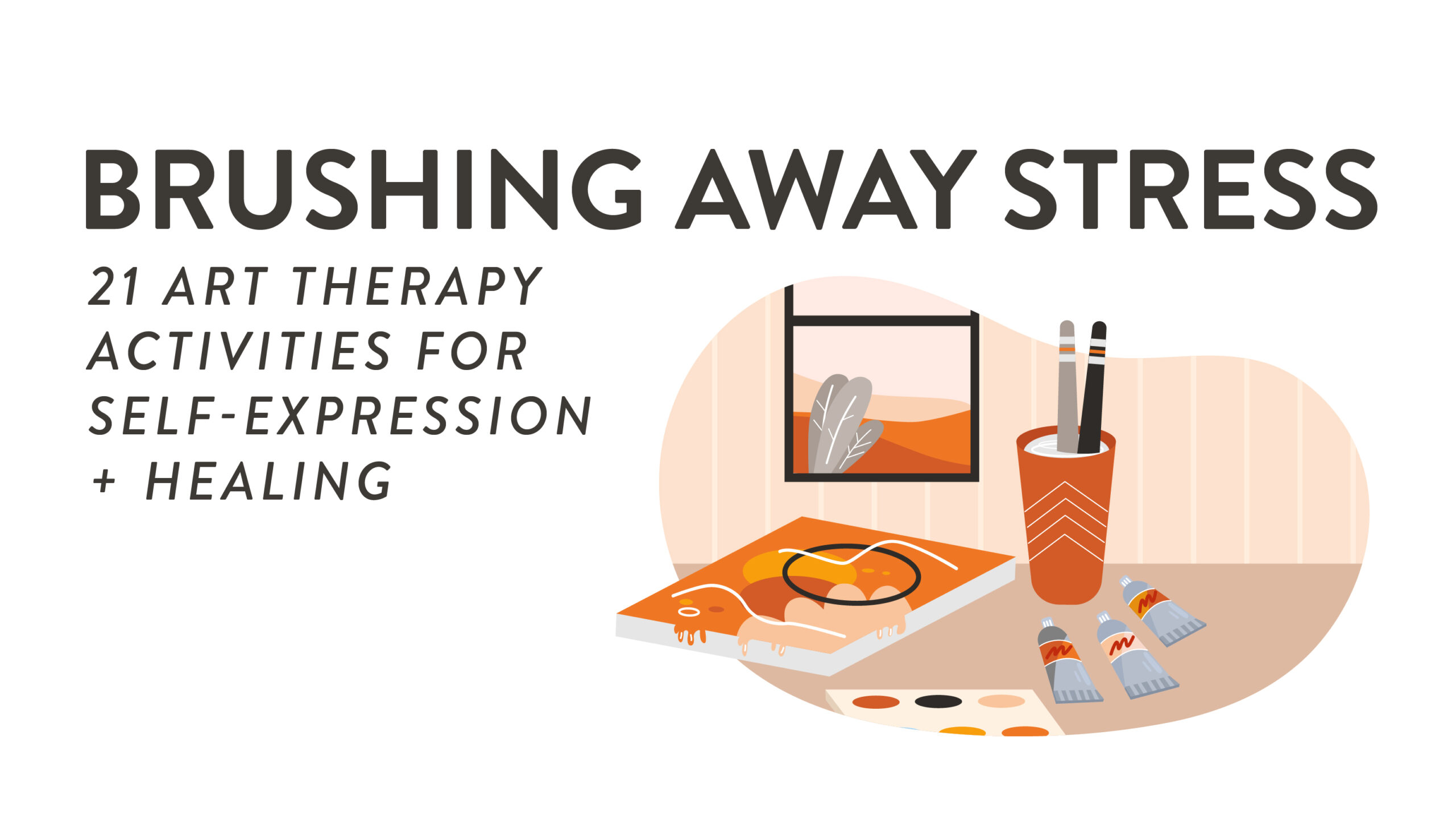Did you know that you don’t need to be a professional artist to reap the benefits of participating in art therapy activities? Unlike classroom art courses, participating in art therapy requires little technique or understanding of the medium at hand. Whether you’re a novice, student, or creative professional, we’re confident you’ll find several therapeutic art projects to pursue as we dive into 21 of our favorites.
Understanding Art Therapy
Before we begin, let’s answer an important question: What is art therapy? The term art therapy was coined by British artist Adrian Hill in 1942, who’s considered to be the founder of the practice. In a formal environment, a licensed art therapist helps individuals of all ages and backgrounds heal from trauma, stress, behavioral issues, and more.
According to the American Art Therapy Association, “When people are struggling, facing a challenge, or even a health crisis —their own words or language fails them.” Simply put, art therapy combines the techniques of traditional therapy with the creative process of making art. Keep in mind that going beyond the singular art media like drawing, painting, and sculpting is known as expressive art therapy, where clients are encouraged to use multiple types of art to express themselves.
Preparing for Art Therapy Activities
Before engaging in any art therapy activities, it’s important to create a calming environment that encourages creativity and self-expression. Going on a photography walk? Visit a location that is familiar and comforting to you. Mindfully doodling? Find a quiet and comfortable space where you can relax and focus without distractions.
Lastly, gather art supplies you might need such as paper, paints, brushes, clay, or markers. Remember, there are no right or wrong ways to create art in therapy – it’s all about the process and what it means to you.
21 Art Therapy Activities for Self-Expression and Healing
From clay sculpting to vision board creation, here’s 21 creative art therapy exercises to try:
1. Mandala Drawing
Utilized as a therapeutic tool, mandala drawing can be a great outlet to begin your art therapy journey. A mandala is a 2D, circular drawing that can contain patterns, sketches, or additional drawings inside. There are no hard rules when it comes to creating them, so don’t be afraid to get creative. According to a study done by the National Library of Medicine, mandala drawing has the power to reduce negative emotions in its creators.
2. Self-Portrait
Creating a self-portrait, whether through illustration, painting, or abstraction, is a great way to explore how you view yourself. Focus on capturing your emotions and inner thoughts when creating your self-portrait. Using this art therapy technique can help you explore your identity and self-perception on a deeper level. Best of all, you can use inexpensive tools found around you such as paper, pens, and pencils.
3. Collage Making
Grab the scissors and glue! Use images and words from magazines and newspapers to create a collage that reflects your personality and identity. This art activity can be a great starting point for those not as confident in their creative ability. Going digital? There are several tools you can use to create collages such as Adobe Photoshop or Canva.
4. Clay Sculpting
Clay sculpting can be a relaxing outlet for those who don’t mind getting their hands a little dirty. During this activity, mold and shape clay to represent your emotions or re-create something that brings you joy. “Sculpting with clay can become a powerful metaphor for personal growth and development,” explains Spotted Rabbit Studio.
Pro tip: If you’re a student, see if your school offers Clay Club which can give you access to an array of materials and tools.
5. Painting to Music
Do you hear that sound? Painting to music is a fun and expressive art therapy project to pursue by yourself or with friends. Listen to the rhythm and melody of your favorite song and create a visual representation of the emotions the music evokes. We suggest using art materials that can flow freely while you paint such as watercolor.
6. Nature-Inspired Art
Nature-inspired art involves using the natural resources around you as inspiration or to create meaningful art. Collect leaves to create a collage, draw the scenery around you, or simply practice art while in nature. The outdoors has a way of calming our minds and is a great environment to practice DIY art therapy.
Note: It’s important to respect your local environment when selecting potential natural art materials.
7. Color Your Mood
Imagine a pie chart with each slice representing your emotions. That’s exactly what coloring your mood is in art therapy. The idea is that you assign a color to each emotion and give it a percentage of space on the pie chart. Tracking how it changes over time can be an excellent way to integrate art therapy into your daily routine.
8. Journaling with Art
Combine art and writing by creating a visual journal. Use drawings, paintings, or collages to explore your emotions, and write about your thoughts and experiences alongside your artwork. Mindful Art Studio states that “It’s one of the most forgiving ways to make art because in an art journal, everything you make is safely contained within your own personal book.”
9. Photography Walks
In today’s age, most everybody owns a camera that can fit into their pocket. Take a camera or your smartphone and go for a walk where you can feel comfortable and safe. Capture images that catch your eye and reflect on your emotions. Photography can be a powerful tool for self-expression and shouldn’t be overlooked.
10. Abstract Art Creation
Let go of trying to create meaning from your work and embrace abstract art. Use colors, lines, and shapes to express your emotions without the need for recognizable forms. This therapeutic art therapy project is a great place to start for beginners as it simply requires a pen, paper, and curious mindset.
11. Story Stones
Story stones therapy involves painting or drawing images on smooth stones and using them to create and tell stories. This activity can help you explore narratives and themes that are meaningful to you. Commonly used by educators and therapists, story stones allow children to use their imagination and advance their vocabulary.
12. Finger Painting
Tap into your inner child and express yourself through a finger painting sensory activity. The hands-on experience of finger painting can be great for developing hand-eye-coordination as well as relieving stress. Try to pick colors that reflect your current emotions to make the most out of this common art therapy activity.
13. Zentangle Art
Zentangle art is a method of creating intricate patterns in a structured and repetitive way, oftentimes with abstract shapes. Using just pen and paper, it can be a calming and meditative practice that can help you focus and find peace.
14. Memory Boxes
Create a memory box by decorating a small box and filling it with objects that hold sentimental value. This activity can help you reflect on memories and emotions tied to specific objects. It can also help you heal from past experiences that certain objects represent.
15. Mindful Doodling
Mindful doodling is the act of doodling through feeling. There are no expectations to create a cohesive drawing in this art therapy exercise. “When you are ready start to make some simple shapes on the paper – all the time keeping your eyes closed. Make lines simply because it feels good to make them and keep your pen moving, keeping your eyes closed and resist the urge to peek no matter what happens,” writes Art in Coaching.
16. Artistic Letter Writing
Artistic letter writing involves writing a letter while adding a creative touch. Common art therapy letter writing often uses images, symbols, and colors to convey messages and emotions. This can be a letter to yourself or someone else, it’s up to you! Either way, reflect on the type of designs you chose and what they mean to you.
17. Gratitude Banners
Looking to put your art therapy on display? Create a banner using colorful paper or fabric and write down things you’re grateful for. Hang it in a place where you can see it daily as a reminder of the things you’re grateful for. If you’d like to get even more creative, consider using images and colors when creating the banner.
18. Mask Making
Mask making offers many possibilities when deciding between material, technique, and aesthetic. Explore your inner self by creating a mask that represents different emotions or aspects of your personality. A common tactic is painting how you think others see you on the exterior, while on the interior painting how you see yourself.
19. Dream Catchers
Originating in Native American culture, dream catchers “symbolize oneness and are indicative of Indigenous identity,” states The Indigenous Foundation. Dream catcher weaving involves using string to wrap around metal or wooden hoops, symbolizing the Earth, which are then decorated with beads and feathers. Using dream catchers as a way to discuss dreams and inner thoughts can be a powerful and therapeutic form of art therapy.
20. Vision Boards
Similar to collage making, a vision board can contain a wide variety of images, words, and art in both a digital and physical representation. A vision board represents your dreams and aspirations whereas making a collage typically represents your mental health and wellbeing. Vision boards can serve as daily reminders of what you wish you accomplish in life.
21. Emotions Wheel
Creating an emotions color wheel can be a meaningful way to represent your feelings in a creative manner. The activity involves dividing a circle into a predefined number of sections which are then each attributed to emotions. You can then color, draw, sketch, or paint what you’d like each emotion to look like. Once completed, reflect on why you chose certain themes, colors, or drawings.
Integrating Art Therapy into Your Routine
Once you’ve found an art medium you enjoy, integrating art therapy activities into your self-care routine has the potential to greatly impact your mental health and wellness. Remember, the process is what matters, not the end result. Take your time, have fun, and allow yourself to relieve stress through mindful art activities.
Pro tip: Remember that art therapy has no age limit. So, get out there and create!
Looking to Further your Passion for Art?
If you are interested in learning more about art + design or art therapy activities, visit our online or campus program pages. For additional resources about this topic, read What’s the difference between an art teacher and art therapist?

